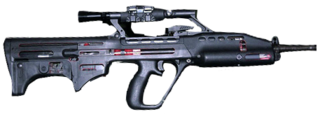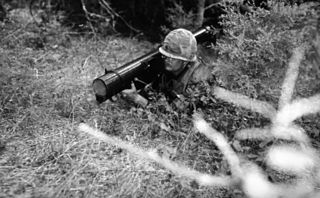
The SA80 is a British family of 5.56×45mm NATO service weapons used by the British Army. The L85 Rifle variant has been the standard issue service rifle of the British Armed Forces since 1987, replacing the L1A1 Self-Loading Rifle. The first prototypes were created in 1976, with production of the A1 variant starting in 1985 and ending in 1994. The A2 variant came to be as the result of a significant upgrade in the early 2000s by Heckler & Koch and remains in service as of 2020. The A3 variant was first issued in 2018 with several new improvements.

The FAMAS is a bullpup assault rifle designed and manufactured in France by MAS in 1978, a year after the Austrian Steyr AUG. It is known by French troops as Le Clairon due to its distinctive shape. The FAMAS is recognised for its high rate of fire at 1,100 rounds per minute. Beginning in 2017, the FAMAS was replaced in most frontline units in the French Army by the HK416F, and the FAMAS is expected to remain in limited service until 2028.

A grenade launcher is a weapon that fires a specially-designed large-caliber projectile, often with an explosive, smoke or gas warhead. Today, the term generally refers to a class of dedicated firearms firing unitary grenade cartridges. The most common type are man-portable, shoulder-fired weapons issued to individuals, although larger crew-served launchers are issued at higher levels of organisation by military forces.

The XM29 OICW was a series of prototypes of a new type of assault rifle that fired 20 mm HE airbursting projectiles. The prototypes were developed as part of the Objective Individual Combat Weapon program in the 1990s. The term SABR was also used at certain points, but is less common.

The Objective Individual Combat Weapon or OICW was the next-generation service rifle competition that was under development as part of the United States Army OICW program; the program was eventually discontinued without bringing the weapon out of the prototype phase. The acronym OICW is often used to refer to the entire weapons program.

An anti-tank rifle is an anti-materiel rifle designed to penetrate the armor of armored fighting vehicles, most commonly tanks, armored personnel carriers, and infantry fighting vehicles. The term is usually used for weapons that can be carried and used by one person, but is sometimes used for larger weapons. The usefulness of rifles for this purpose ran from the introduction of tanks in World War I until the Korean War. While medium and heavy tank armor became too thick to be penetrated by rigid projectiles from rifles that could be carried by a single soldier, anti-tank rifles continued to be used against other "soft" targets, though recoilless rifles and rocket-propelled grenades such as the bazooka were also introduced for infantry close-layer defense against tanks.

An anti-materiel rifle (AMR) is a rifle designed for use against military equipment, structures, and other hardware (materiel). Anti-materiel rifles are chambered in significantly larger calibers than conventional rifles and are employed to eliminate equipment such as engines and unarmored or lightly armored targets. While modern armored vehicles are resistant to anti-materiel rifles, the extended range and penetration still has many modern applications. While not intended for use against human targets, the bullet weight and velocity of anti-materiel rifles gives them exceptional long-range capability even when compared with designated sniper rifles. Anti-materiel rifles are made in both bolt-action as well as semi-automatic designs.

The SAR 21 is a bullpup assault rifle designed and manufactured in Singapore, chambered for the 5.56x45mm cartridge. First revealed and subsequently adopted by the Singapore Armed Forces (SAF) as its standard service weapon in 1999, it was designed and developed over a four-year period to replace the locally license-built M16S1 by the Ministry of Defence (MINDEF), Singapore Army and the former Chartered Industries of Singapore (CIS), presently ST Engineering Land Systems. Many of its design features are directly intended to address the weaknesses of the M16S1 as encountered operationally by some infantrymen.

The LAW 80, regularly referred to as LAW 94 in British service, is a man-portable, disposable anti-tank weapon previously used by the British Army and a few other militaries.
The Special Purpose Individual Weapon (SPIW) was a long-running United States Army program to develop, in part, a workable flechette-firing "rifle", though other concepts were also involved. The concepts continued to be tested under the Future Rifle Program and again in the 1980s under the Advanced Combat Rifle program, but neither program resulted in a system useful enough to warrant replacing the M16.

The GP-25 Kostyor ("Bonfire"), GP-30 Obuvka ("Footwear") and GP-34 are a family of Russian 40 mm under-barrel grenade launchers for the AK family of assault rifles. They were first seen by the West in 1984 during the Soviet Invasion of Afghanistan. The GP-30 was lightened and the redesigned sighting system was moved to the right.

The Panzerfaust 3 is a modern semi-disposable recoilless anti-tank weapon, which was developed between 1978 and 1985 and first entered service with the Bundeswehr in 1987. It was first ordered in 1973 to provide West German infantry with an effective weapon against contemporary Soviet armor, thereby replacing West Germany's aging PzF 44 Light Lanze launchers and the heavy Carl Gustaf 84 mm anti-tank recoilless rifle manufactured in Sweden.

The RAC 112 APILAS is a portable one-shot 112 mm recoilless anti-tank weapon, designed in France by GIAT Industries. Over 120,000 of the APILAS launchers have been produced, and they are in service with many countries.
The Advanced Individual Combat Weapon (AICW) was an Australian prototype combination assault rifle and grenade launcher developed as a technology demonstrator. The AICW combined a standard 5.56 mm assault rifle based on the successful F88 Austeyr with a superposed load grenade launcher developed by Metal Storm.

The QLZ-87 35 mm automatic grenade launcher (AGL) is an air-cooled, gas operated fully automatic weapon and is crew transportable (12~20 kg) with limited amounts of ammunition. Unusual for handheld grenade launchers, the QLZ-87 fires 35x32 mmSR high-velocity grenades, which provides longer range and flatter firing trajectory.

The Manufacture d'Armes de Saint-Étienne, often abbreviated to MAS was a French state-owned weapons manufacturer in the town of Saint-Étienne, Loire. Founded in 1764, it was merged into the French state-owned defense conglomerate GIAT Industries in 2001.

The BS-1 RGA-86 "Tishina" / BS-1M 6S1 "Kanareyka" is a silenced Soviet 30mm grenade launcher. It was developed specifically for the Spetsnaz. It uses a bolt-action mechanism to load blanks into the chamber along with the 30mm grenade VOG-T (ВОГ-Т). Pulling the trigger ignites the blank which in turn ignites the charge on the grenade causing the grenade to be expelled from the barrel.
The Wasp 58 is a 58-mm rocket launcher antitank weapon developed in France in the late 1980s. The weapon was, originally, privately developed by the French firm Luchaire SA, subsidiary of GIAT.
The high–low system is a design of cannon and anti-tank warfare launcher using a smaller high-pressure chamber to store propellant. It allows a much larger projectile to be launched without the heavy equipment usually needed for large caliber weapons. When the propellant is ignited, the higher pressure gases are bled out through vents at reduced pressure to a much larger low pressure chamber to push a projectile forward. The high-low system allows the weight of the weapon and its ammunition to be reduced significantly. Production cost and time are drastically lower than for standard cannon or other small-arm weapon systems firing a projectile of the same size and weight. It has a far more efficient use of the propellant, unlike earlier recoilless weapons, where most of the propellant is expended to the rear of the weapon to counter the recoil of the projectile being fired.
The Type 11, designated as QTS-11, is an air burst grenade launcher integrated with the QBZ-03 assault rifle in service of Chinese military since 2015. Reporting on the weapon as early as February 2011 initially identified the weapon as the ZH-05.


















